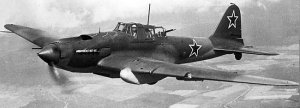
This is an overview of the most important Soviet aircraft of WW II.
Fighters
At the start of the war with Germany, the Polikarpov I-16 was the most numerous fighter. It was armed with two 7.62mm MGs and two 20mm cannons, at lower altitudes it performed equal to the Bf109E. The MiG-1 and MiG-3 were used somewhat, but were not liked due to their deficiencies.
The most numerous and successful fighters were the Yakovlev Yak-1 to Yak-9 models. The Yak-1 had one 20mm cannon and one 12.7mm MG. The Yak-3 added a second MG. The Yak-7 had a 20mm cannon and two 7.62mm MGs. The most numerous type, the Yak-9, was introduced in late 1942. Armament consisted on a 20mm cannon and a 12.7mm MG.
The other numerous series of fighters were the Lavochkin LaGG-3, La-5, and La-7. The two later models were armed with two 20mm cannons
Bombers
In 1941 the Tupolev SB was practically the only bomber in the Soviet air force. It could carry a 600kg bomb load. 1941 also saw the introduction of the Petlyakov Pe-2, which could carry a much improved load of 1,600 kg. It was accompanied by the Tupolev Tu-2, a plane with similar capabilities. The Ilyushin Il-4 was introduced in 1942, capable of carrying 2,600kg of bombs.
The most numerous bomber/attack plane was of course the Ilyushin Il-2 Sturmovik and it’s Il-10 successor introduced in 1944. Some 30,000 Il-2s were built throughout the war. Early models were single-seaters. Huge losses to fighters prompted the addition of a rear gunner in 1942. The Il-2 had two cannons, either 20mm or 23mm, two 7.62mm MGs, and was capable of carrying up to 600kg of bombs. The Il-10 did not have forward-firing MGs.
Others
The most numerous aircraft of the Soviet air force was the Polikarpov Po-2 biplane. It was used for many roles, including trainer and night attacks, where it proved to be difficult to shoot down due to its low speed and low flying.
The Lisunov Li-2 was a license-built transport aircraft based on the Douglas DC-3.
Paint schemes
The Soviet aircraft used a variety of paint schemes, including special winter schemes. Undersides seem to have been predominantly blue-gray, and camouflage was often green-brown or green-gray.
Aircraft of WW II: Germany – Great Britain – US Air Force – US Navy – Japan – Soviet Union.